
Susan Cummins: This show at Aaron Faber gallery includes 125 pieces. Is it a kind of retrospective? Are you showing sketches and photographs along with the jewelry? Can you describe the installation?
Sydney Lynch: The Aaron Faber show is more of a cross-section of my current work, rather than a retrospective. I have always created both a production line and one-of-a-kind designs, so there is a range from both bodies of work. The shell and coral pieces, which I made for the Aaron Faber 40th Anniversary show, are also on display. That small series was an opportunity for me to have fun designing and making pieces that were personal to me, incorporating finds from beachcombing in Mexico.
You mention on your website that while you were in college you worked on a Navajo reservation and that it was there you were inspired to make your own jewelry. Can you tell us this story?
Sydney Lynch: When I was 19, a sophomore in college, I spent six weeks as a teacher’s aide on the Navajo reservation in Arizona. It was a transformative experience on all levels. I grew up in Connecticut, and had never experienced the Western landscape. The powerful geography of the open desert, rocks, and canyons was thrilling, and I decided then and there to move out west, and have never lived on the East Coast again. It was also an opportunity for learning about native culture.
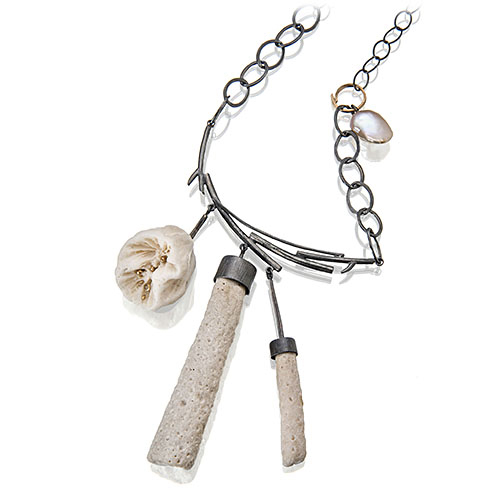
Susan Cummins: This show at Aaron Faber gallery includes 125 pieces. Is it a kind of retrospective? Are you showing sketches and photographs along with the jewelry? Can you describe the installation?
Sydney Lynch: The Aaron Faber show is more of a cross-section of my current work, rather than a retrospective. I have always created both a production line and one-of-a-kind designs, so there is a range from both bodies of work. The shell and coral pieces, which I made for the Aaron Faber 40th Anniversary show, are also on display. That small series was an opportunity for me to have fun designing and making pieces that were personal to me, incorporating finds from beachcombing in Mexico.
You mention on your website that while you were in college you worked on a Navajo reservation and that it was there you were inspired to make your own jewelry. Can you tell us this story?
Sydney Lynch: When I was 19, a sophomore in college, I spent six weeks as a teacher’s aide on the Navajo reservation in Arizona. It was a transformative experience on all levels. I grew up in Connecticut, and had never experienced the Western landscape. The powerful geography of the open desert, rocks, and canyons was thrilling, and I decided then and there to move out west, and have never lived on the East Coast again. It was also an opportunity for learning about native culture.
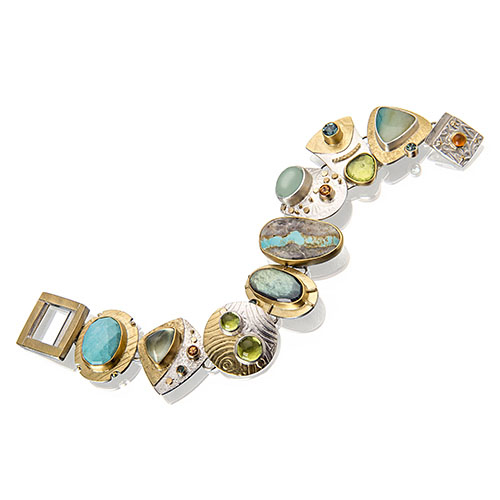
My time in that landscape and culture was like falling in love forever. The environment resonated with me, and I was hooked.
You obviously love natural materials—stones, pebbles, coral, shells, pearls, etc. I understand that you often arrange these things into collections. Why do you think the process of ordering these objects holds such a draw for you?
Sydney Lynch: My house is filled with little collections of pebbles and shells that I’ve picked up while traveling. I’ve loaded many a suitcase with my finds and hauled them around to every apartment and house in which I’ve lived. When I went to the University of Colorado after leaving the Navajo reservation and took my first metalsmithing classes, I remember feeling culturally bereft at not having a strong tradition like the Native American silversmiths had. I copied aspects of their work for a while, and then realized I couldn’t adopt someone else’s culture. The Navajo-inspired silver beads I was making slowly evolved into pebble shapes like the rocks I’d been collecting, and I began to use those beautiful organic shapes more and more in my work. My designs are organic and asymmetrical and reflect shapes I find in nature, though they are rarely direct efforts to re-create natural forms.
Humans have always arranged shapes in either symmetrical patterns, or—my preference—balanced, asymmetrical arrangements. I don’t know why this is so pleasing to me, but I love it. It’s the mystery element that I don’t have a straight answer for.
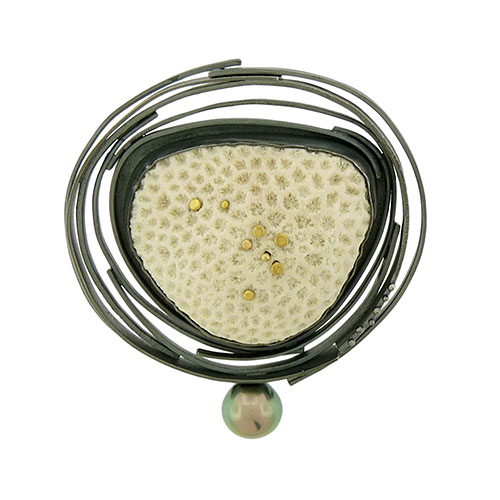
You also seem to like unusual cuts in stones. Do you make these yourself or do you have a secret supplier?
Sydney Lynch: I don’t do any lapidary work myself, but I’m very particular about selecting stones. It’s a lot like beachcombing: for example, I can look at hundreds of dendritic quartzes and choose only a few. I know instinctively what will work or what will inspire me. Surprisingly, last year was the first time I attended the Tucson show, and it was also the first time I’ve ever maxed out my credit card! Like walking head down along the beach, when I shop for stones I’m searching for the right stones to catch my eye.
Who are the most inspiring jewelers, in your opinion?
Sydney Lynch: Having to choose the most inspiring jewelers is a tough question. With such a broad spectrum of styles and materials being used, and so many jewelers I admire, I don’t like to single out anyone. A few of my favorites include my friend Judith Kinghorn, whom I tell she is my personal jewelry goddess! I could never have the patience for the level of detail required for her work, and it’s beautiful. Michael Zobel’s and Peter Schmid’s work appeals to me with its bold designs and innovative constructions incorporating interesting stones and textures. In terms of jewelers whose work I’m drawn to and is totally different from mine, I think of Karen Gilbert or Wendy McAllister—they both work in materials and techniques that I have no experience with, and I find their designs refreshing and surprising.
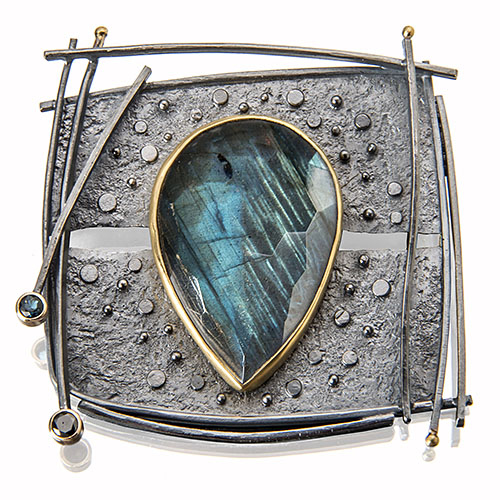
Do you make a living from making jewelry? How?
Sydney Lynch: Since my first ACC show at Rhinebeck in 1983, I’ve made a living full-time from my jewelry. Starting with zero business training, it was a long learning curve. Having both a production line and one-of-a-kind pieces has enabled me to have a variety of prices and designs that appeal to a wide range of people. I listen to suggestions from customers and buyers and am open to their feedback. I pay attention to what sells and what doesn’t sell. For instance, there are loads of women who want something handmade and distinctive, but need fairly conservative jewelry for work, and I’m not opposed to creating designs for that niche. Of course I’d prefer to only make one-of-a-kind pieces, but I also don’t want to have a day job!
I employ two, sometimes three, benchworkers in my studio, and my husband does the bookkeeping and various other studio- and show-related details. We are a team, and I could not make a living entirely by myself. I still design everything and make prototypes and some one-of-a-kind pieces, but a lot of my job these days seems to be organization and communications.
There is no formula for how to make a living selling your jewelry. Each of the jewelers that I know has created a balance that suits their wants and needs. I don’t have the patience for custom work, nor do I want to be tied down to a retail store. Seventy percent of my business is wholesale, and I do a few retail shows a year. I sell online, but it doesn’t provide a steady or substantial percentage of revenue. I’m always reevaluating which venues and events I should get involved in each year. Several years ago, when the market for handmade jewelry was dangerously slow, I decided to try the JCK show. It’s very commercial, but I discovered quite a few buyers, old and new, there. Basically, I’m very pragmatic and not attached to what I think of as art school “purism.”
I also pay attention to marketing trends. I had a website fairly early on, got on board with Facebook, Pinterest, and, more recently, Instagram. Five years ago I started sending out a monthly newsletter/blog to both retail and wholesale customers. People tell me they love it, and it’s a great way to stay connected. Selling handmade work is all about personal relationships. Just don’t ask me to Tweet.
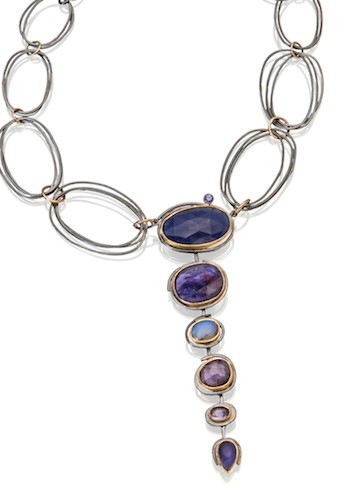
Sydney Lynch: When I was growing up, National Geographic magazine was my “Internet,” introducing me to exotic places and new cultures. Traveling is what I love, being in new environments or visiting old favorites. A week at home is routine, but a week in a new place is filled with possibility and unexpected encounters. When I travel for business, my husband usually accompanies me, and we always try to investigate whatever city we’re in, even if we only have one free day, even in Las Vegas!
Photography has taken the place of a sketchbook, and the hundreds of photos I take when traveling are a way to replenish my creative eye and provide sources of color, line, form, texture. We were in Oaxaca and San Cristobal de las Casas for a few weeks this fall. I love Mexico for its exuberant color, its spirit and history, and the people I’ve met there. I’m especially attracted to Mexican textiles, and the weaving and embroidery in these areas of the country are impressive and beautiful. Jewelry design is never my mission as I travel, but all that visual stimulation seeps into my mental hard drive and eventually influences my work.
When you travel do you look for the way jewelry fits into the culture? Can you give us an interesting example?
Sydney Lynch: I haven’t traveled in areas where jewelry has a prominent role in the culture, such as Asia or Africa. In Mexico and Ecuador, there is a lot of poverty, and traditional costumes are centered on textiles rather than metalwork. On the other hand, I have visited museums displaying gorgeous pre-Colombian gold- and silverwork that are impressive in their technical virtuosity, given the relatively primitive tools available during that era.
In a museum in Oaxaca, there is a collection of perfectly preserved jewelry from a tomb at Monte Alban that is amazing. When I was growing up, my earliest exposure to metalsmithing virtuosity was at the Met, seeing exhibits of Roman and Scythian gold.
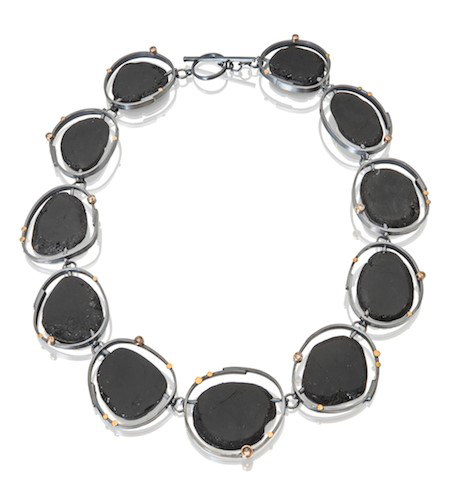
Sydney Lynch: Landscape has always had a strong effect on me. I grew up in the woods of Connecticut, and spent summers on the beach at Long Island Sound before moving west. After years in the Colorado mountains and southwestern deserts, I’ve now lived half my life in the Great Plains. The wide expanse of the prairie is exhilarating and peaceful at the same time; it gives you room to stretch and breathe. Looking at the horizon of sky and grasslands is a lot like looking at the ocean. It’s a subtle place, and it has forced me to look closely for nuance and detail—great training for a jeweler. In Nebraska, you sometimes have to look harder for interesting details, and they are there. As a visual person, I’d say living here has trained me to look at my surroundings closely and carefully.
What do you do in your spare time?
Sydney Lynch: In my spare time I like to be active, bicycling, swimming, or walking. I went on my first long-distance bike tour in Nebraska last summer and just signed up for the 2015 Tour de Nebraska—293 miles in five days.
I have been studying Spanish for several years and have spent time in Mexico taking language immersion classes. My table is always piled with partially read books and magazines, and I listen to audio books in the studio. I also love movies and theater. Lately I’ve been trying to get back to knitting, though it’s not easy to find time to sit and knit. I love spending time with friends. We are all pretty good cooks and enjoy feasting together. My daughter lives in L.A., and I spend time with her when I can, though never often enough.
Thank you.




